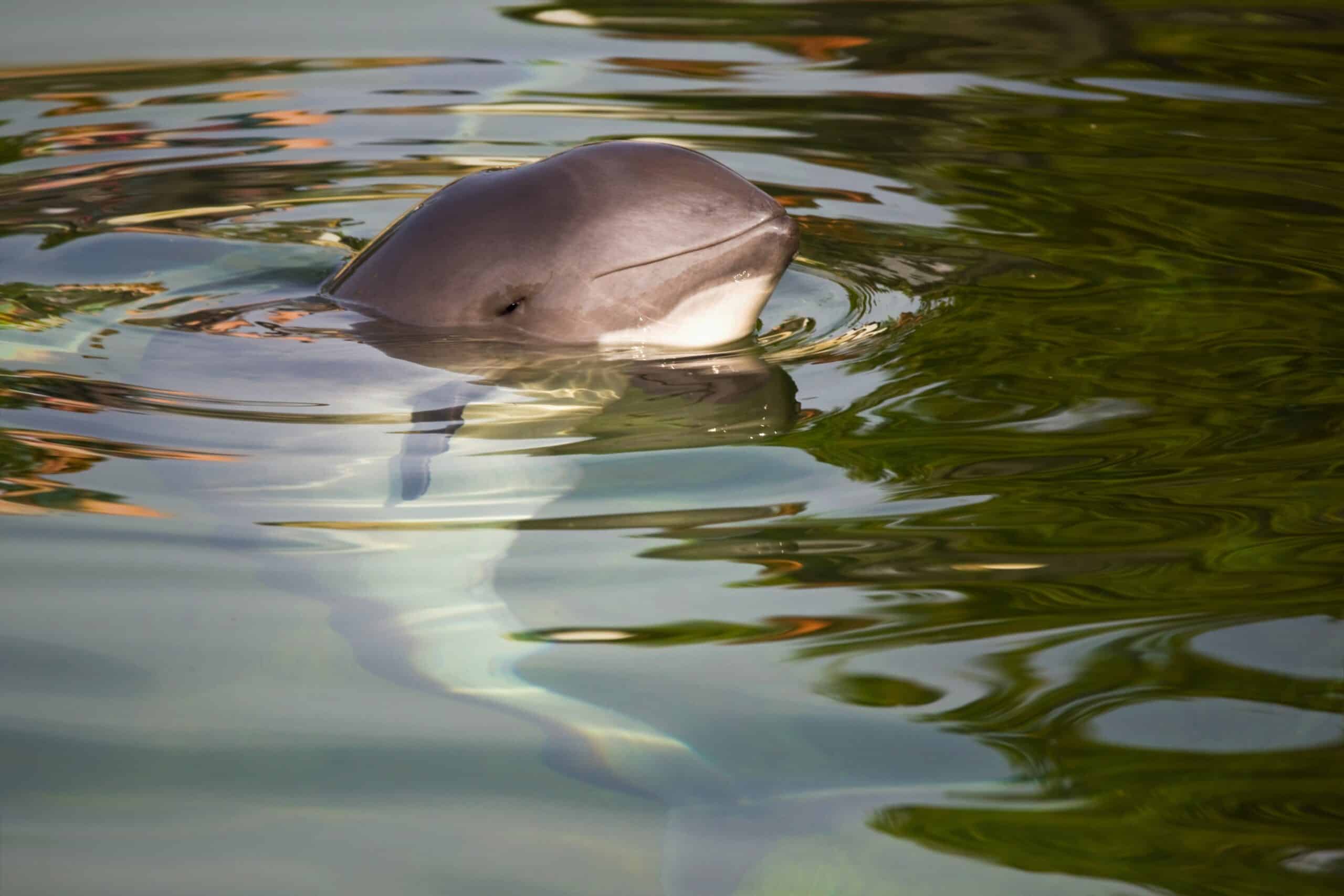The deep ocean is one of the most mysterious and unexplored places on Earth, home to a fascinating array of marine creatures that have adapted to survive in its extreme conditions. From the eerie glow of bioluminescent fish to the ancient, armor-like shells of deep-sea crabs, these creatures are as unique as they are remarkable. In this article, we’ll dive into the depths to explore the top 16 most unique marine creatures found in the deepest parts of our oceans, each with its own extraordinary features that set it apart in the underwater world.
Japanese Spider Crab

The Japanese Spider Crab (Macrocheira kaempferi) is a fascinating deep-sea creature that holds the title for having the largest leg span of any arthropod, reaching up to 12 feet (3.7 meters) across. This massive crustacean, which can weigh up to 44 pounds (20 kilograms), is found at depths ranging from 150 to 600 meters (490 to 1,970 feet) around the Pacific coast of Japan, particularly in the waters surrounding the Japanese archipelago. Despite its intimidating appearance, the Japanese Spider Crab is known to be a scavenger, feeding mainly on dead fish, plant material, and shellfish. Its long legs, which seem almost delicate, allow it to navigate the rocky ocean floor with surprising agility, while its tough, armored exoskeleton provides protection from predators. One of the most unique aspects of this crab is its life cycle, with larvae spending their early days in shallow waters before migrating to the deep sea as they mature. The Japanese Spider Crab’s combination of size, unusual appearance, and adaptability to the harsh conditions of the deep ocean make it a truly unique marine creature.
Flapjack Octopus
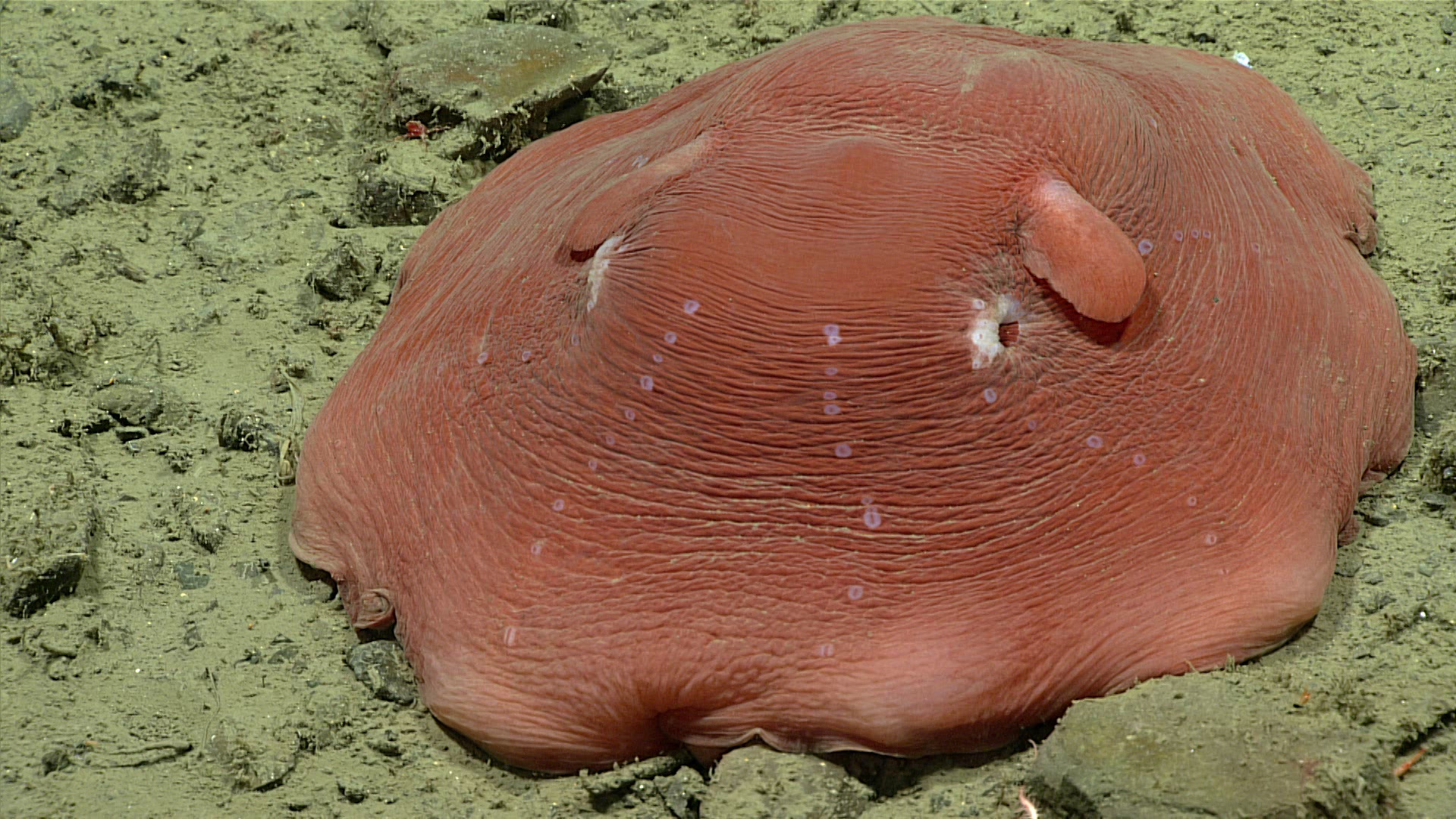
The Flapjack Octopus (Opisthoteuthis californiana), often referred to as the “adorable” octopus, is a small, deep-sea species found at depths ranging from 500 to 1,500 meters (1,640 to 4,920 feet). This creature gets its name from its distinctively flat, round body, which resembles a pancake or “flapjack.” Unlike other octopuses that exhibit more dynamic movements, the Flapjack Octopus propels itself by gently flapping its webbed arms, giving it an almost ethereal appearance as it glides through the dark waters. One of the most remarkable features of this species is its ability to change its body color to blend in with its surroundings, a crucial adaptation for avoiding predators in the deep sea. The Flapjack Octopus is also known for its unusual reproductive strategy; females produce relatively few, large eggs, which they carefully tend to until they hatch. This slow reproduction process is typical of deep-sea creatures, where resources are scarce, and survival requires significant energy investment. The Flapjack Octopus’s combination of charming appearance, unique locomotion, and specialized adaptations to its environment make it a standout among deep-sea fauna.
Sea Pig
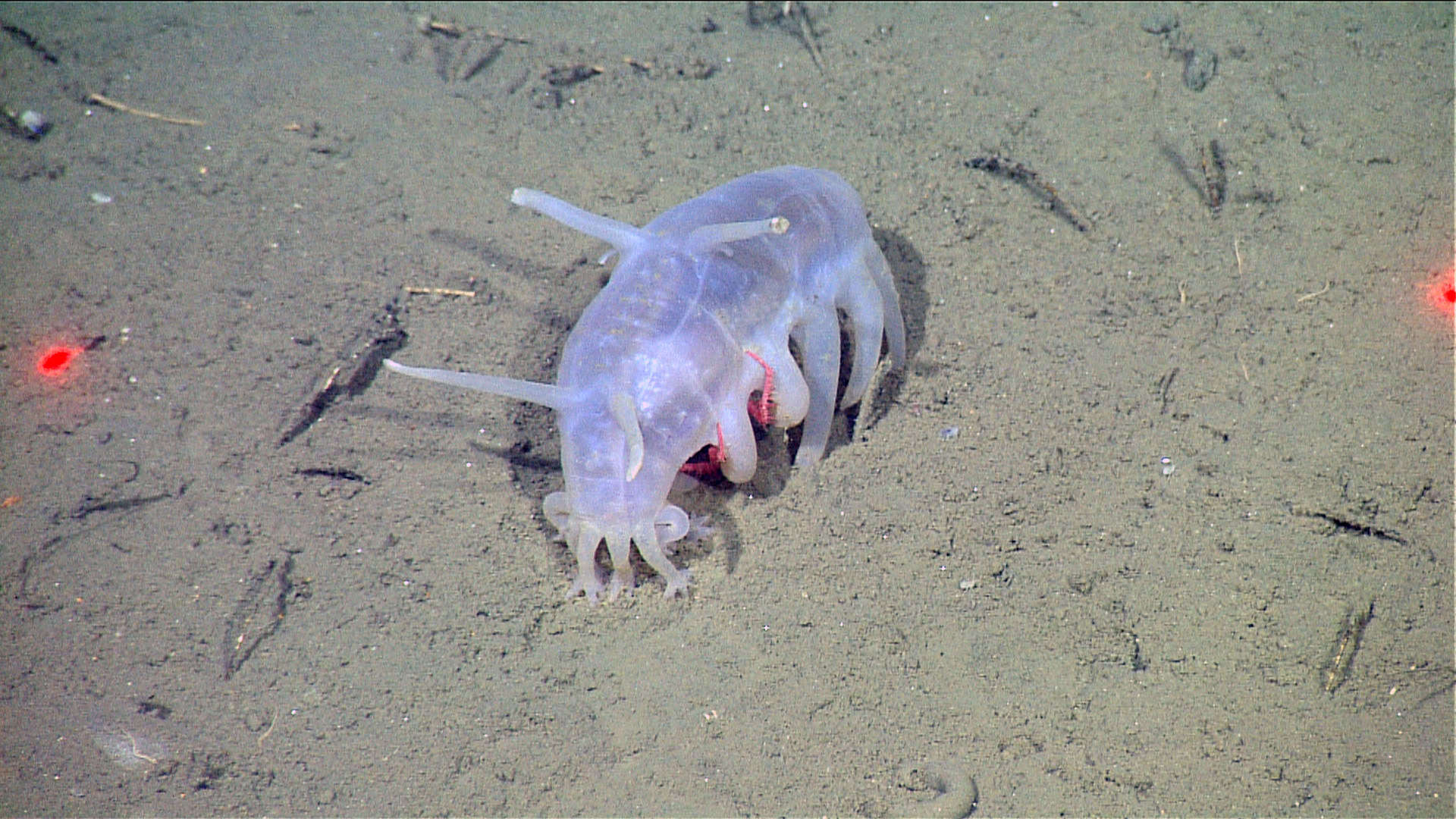
The Sea Pig (Scotoplanes globosa) is a type of sea cucumber that lives on the deep ocean floor, typically at depths of over 1,000 meters (3,280 feet). This unusual creature, which can grow up to 6 inches (15 centimeters) long, has a plump, pinkish body with tube-like feet that give it a pig-like appearance, hence its name. Sea Pigs are scavengers, feeding on organic particles that settle on the ocean floor. They play a vital role in the deep-sea ecosystem by recycling nutrients from decaying matter. One of the most unique aspects of Sea Pigs is their method of locomotion; they move using hydraulic pressure to inflate and deflate their tube feet, allowing them to crawl along the seabed. Interestingly, they are often found in large groups, which may help them in finding food or deterring predators. Another unique feature is their symbiotic relationship with parasitic worms that often live on their bodies. Despite their strange appearance, Sea Pigs are incredibly well-adapted to the extreme conditions of the deep sea, including high pressure, low temperatures, and complete darkness, making them one of the most unique and intriguing creatures of the deep ocean.
Giant Isopod
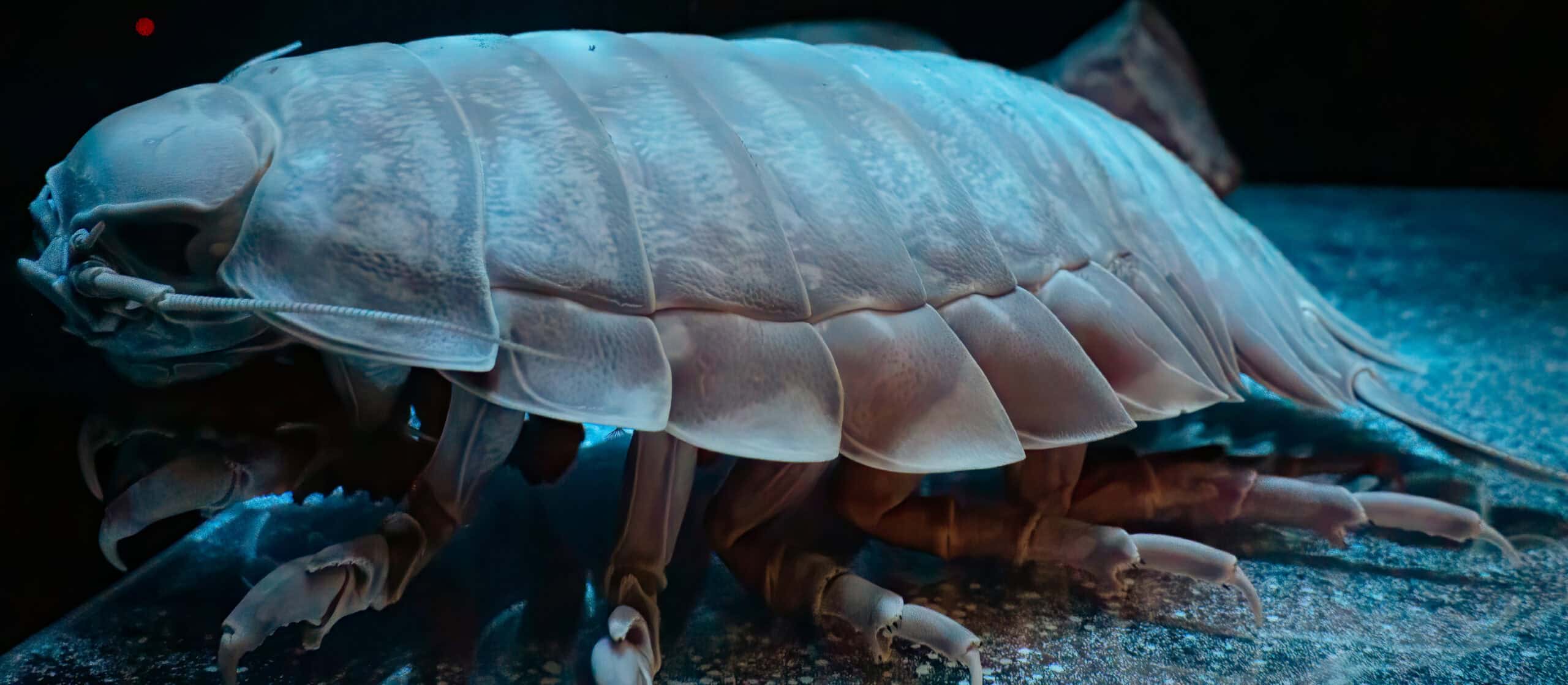
The Giant Isopod (Bathynomus giganteus) is a deep-sea crustacean that resembles a giant pill bug, and it is one of the largest members of the isopod family. These creatures can grow up to 16 inches (40 centimeters) in length and are found at depths ranging from 500 to 7,000 feet (150 to 2,130 meters) in the cold, dark waters of the Atlantic, Pacific, and Indian Oceans. Giant Isopods are scavengers, feeding on the remains of dead fish, whales, and other marine animals that sink to the ocean floor. They have a tough exoskeleton divided into segments, which provides protection from predators, and their large compound eyes are adapted to detect even the faintest light in the deep sea. One of the most unique features of the Giant Isopod is its ability to survive long periods without food—up to several years in some cases—by entering a state of deep hibernation. This adaptation is essential for survival in the nutrient-poor environments of the deep ocean. The Giant Isopod’s prehistoric appearance, enormous size, and ability to thrive in one of the Earth’s most extreme environments make it one of the most unique marine creatures of the deep.
Sea Angel
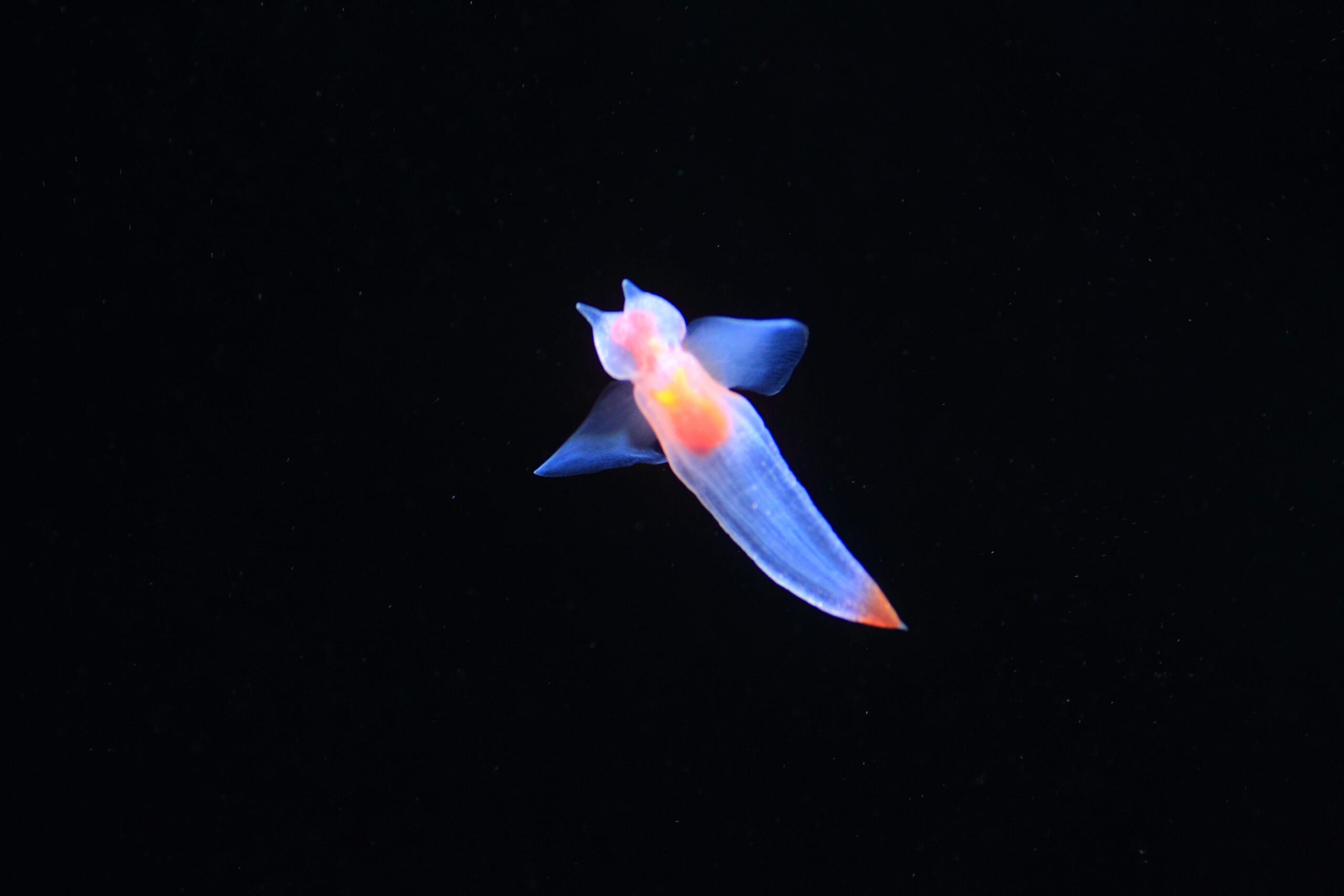
The Sea Angel (Clione limacina) is a tiny, ethereal-looking mollusk found in the deep, cold waters of the Arctic and Antarctic Oceans, typically at depths of 100 to 500 meters (330 to 1,640 feet). Despite its angelic name and appearance, this creature is a voracious predator. It has a translucent, wing-like body that it uses to “fly” through the water, giving it a ghostly, otherworldly appearance. Sea Angels are hermaphroditic and possess both male and female reproductive organs, which allows them to reproduce more efficiently in the sparse deep-sea environment. Their diet primarily consists of smaller sea slugs, which they capture using specialized, retractable tentacles equipped with sharp hooks. One of the most unique aspects of the Sea Angel is its ability to survive in the frigid temperatures of the deep ocean, where it uses a form of antifreeze in its body fluids to prevent freezing. The combination of its delicate, angel-like appearance, predatory nature, and extreme environmental adaptations makes the Sea Angel one of the most unique and captivating creatures in the deep sea.
Giant Larvacean
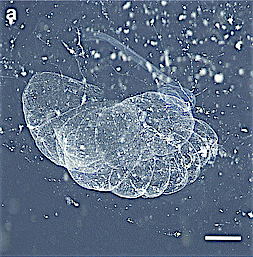
The Giant Larvacean (Bathochordaeus charon) is a solitary deep-sea filter feeder found at depths of up to 1,000 meters (3,280 feet) in the world’s oceans. Despite its name, the Giant Larvacean is not particularly large, with a body size of only about 2 inches (5 centimeters), but it creates a massive mucous “house” around itself that can be up to 3 feet (1 meter) in diameter. This mucous structure, which the Larvacean constructs and then lives within, acts as a filter to trap tiny particles of food, such as plankton and detritus. The Larvacean regularly sheds and rebuilds this structure, sometimes several times a day, which contributes to the vertical flux of organic material in the ocean, essentially feeding the deep sea. The transparent, ghostly appearance of the Larvacean and its intricate, delicate house make it one of the most unique creatures in the deep sea. Moreover, its ability to influence carbon cycling in the ocean through its mucous structures highlights its importance in the deep-sea ecosystem, making the Giant Larvacean a fascinating and unique marine creature.
Bloodybelly Comb Jelly
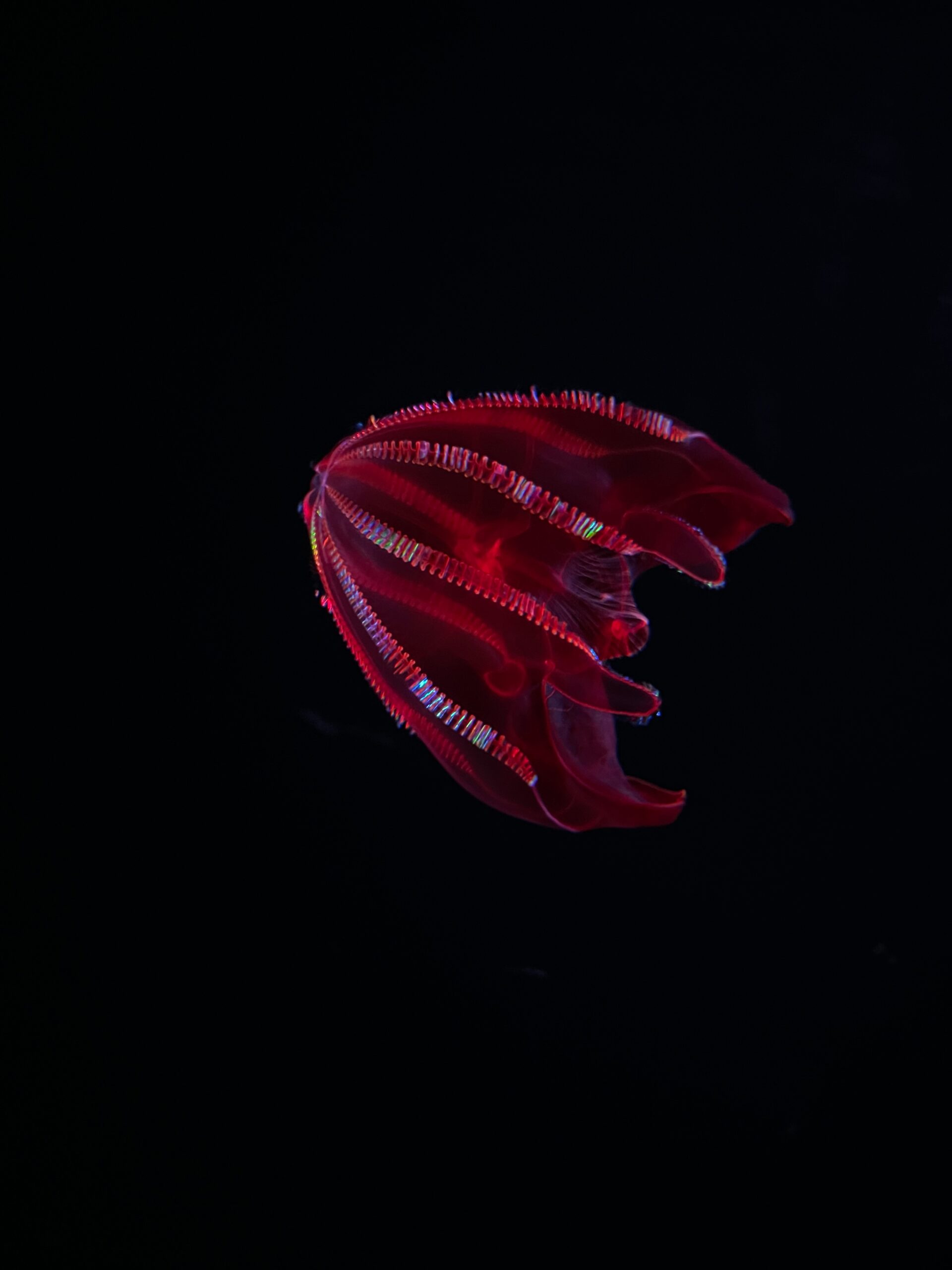
The Bloodybelly Comb Jelly (Lampocteis cruentiventer) is a strikingly colorful deep-sea jellyfish that inhabits the dark depths of the ocean, typically found at depths of 1,200 to 3,000 meters (3,940 to 9,840 feet). Its most distinctive feature is its deep red belly, which is thought to be an adaptation to hide the bioluminescence of its prey, making it less visible to predators in the pitch-black environment of the deep sea. The Bloodybelly Comb Jelly has rows of cilia, known as combs, which it uses to move through the water. When light is reflected off these combs, it creates a mesmerizing, rainbow-like effect that contrasts beautifully with its deep red coloration. Unlike true jellyfish, comb jellies do not sting; instead, they capture prey using sticky cells on their tentacles. The combination of its vivid coloration, unique method of locomotion, and specialized adaptations to deep-sea life makes the Bloodybelly Comb Jelly one of the most unique and visually striking creatures found in the ocean’s depths.
Anglerfish
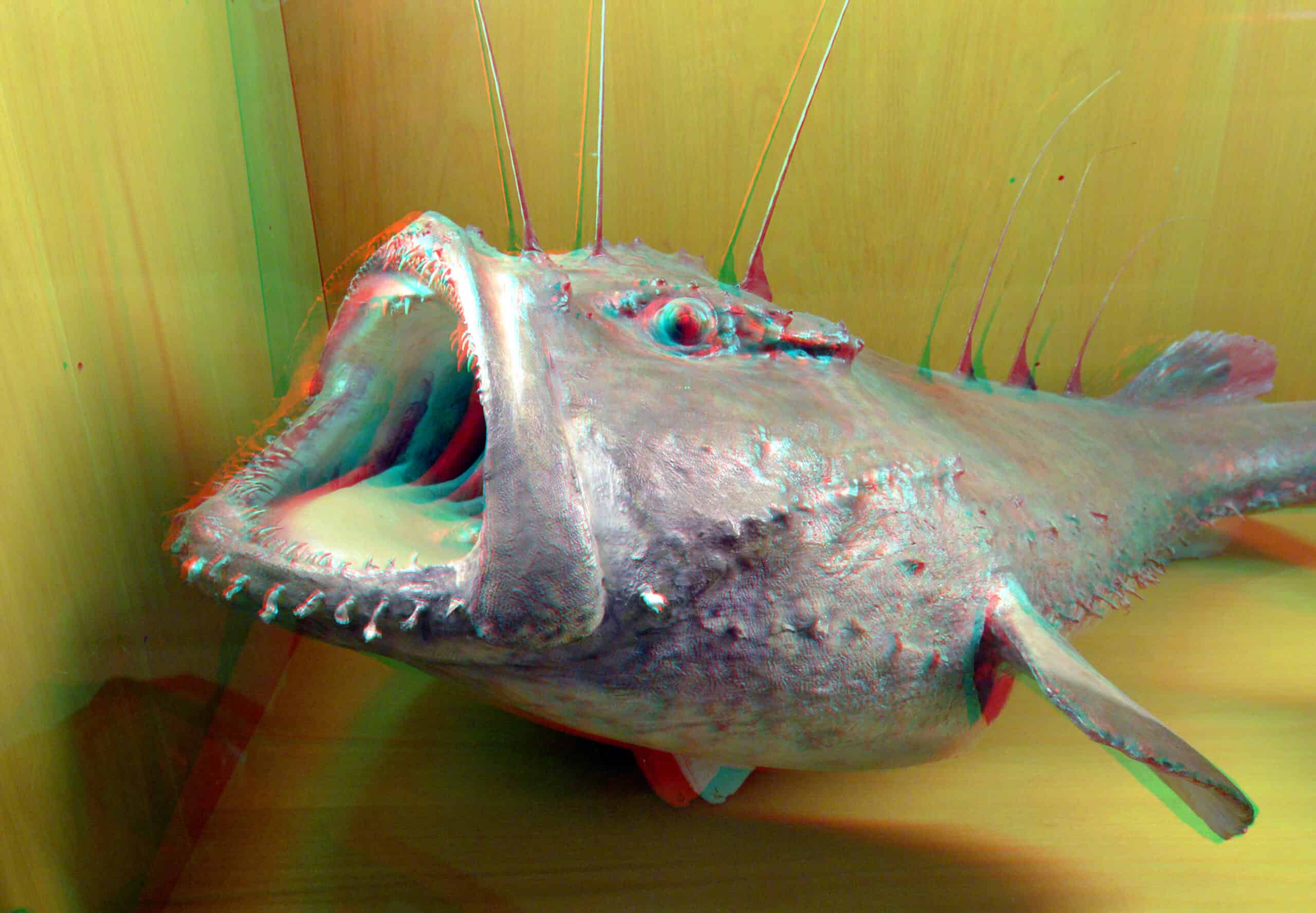
The Anglerfish is one of the most iconic and fearsome creatures of the deep sea, known for its bioluminescent lure that protrudes from its head. This lure, which contains symbiotic bacteria that produce light, is used to attract prey in the dark depths of the ocean, where the Anglerfish typically resides at depths of 1,000 to 3,000 meters (3,280 to 9,840 feet). Female Anglerfish can grow up to 3.3 feet (1 meter) in length, while males are significantly smaller and often fuse to the female’s body in a parasitic relationship, providing sperm in exchange for nutrients. The Anglerfish’s enormous mouth and sharp teeth allow it to consume prey nearly as large as itself, making it a formidable predator in the deep sea. One of the most unique aspects of the Anglerfish is its reproductive strategy, where the male essentially becomes a part of the female’s body, a rarity in the animal kingdom. This adaptation, along with its eerie appearance and ability to thrive in one of the harshest environments on Earth, makes the Anglerfish one of the most unique and fascinating marine creatures.
Giant Siphonophore
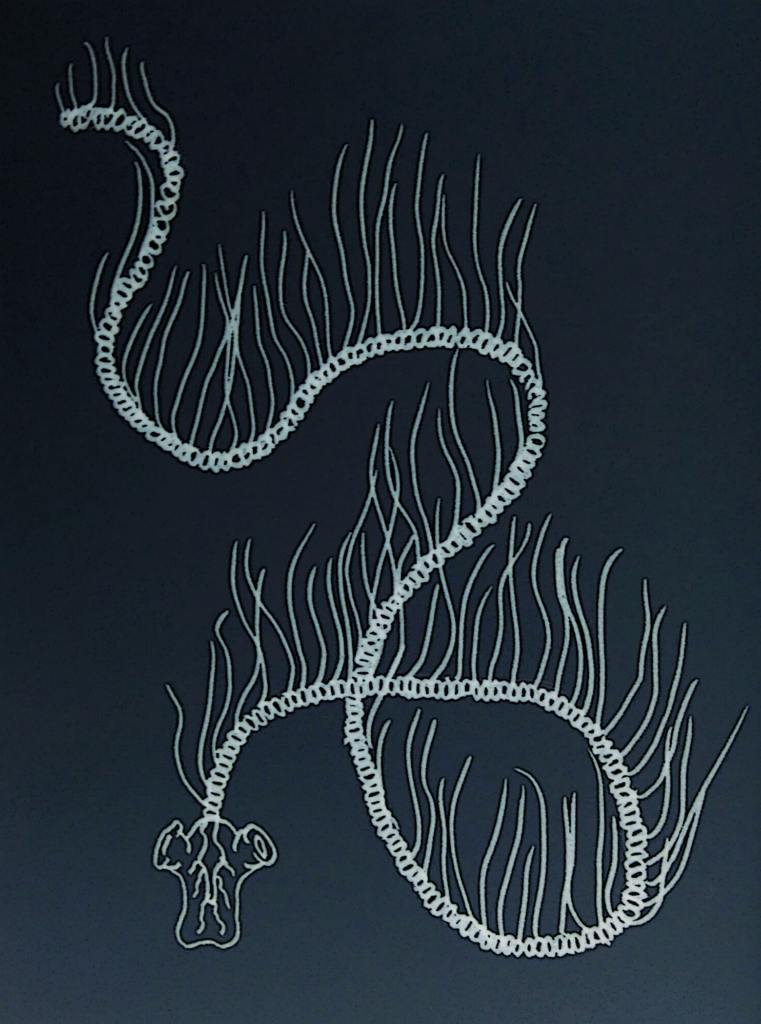
The Giant Siphonophore (Praya dubia) is a colonial organism found in the deep sea, often at depths exceeding 1,000 meters (3,280 feet). Remarkably, it can reach lengths of up to 130 feet (40 meters), making it one of the longest animals in the world. Despite its appearance as a single entity, the Giant Siphonophore is actually composed of numerous specialized zooids, each with a specific function, such as feeding, reproduction, or locomotion. These zooids are genetically identical but work together in a highly coordinated manner, creating a complex, efficient organism. The siphonophore’s body is bioluminescent, emitting a soft blue or green glow that can be used to attract prey or communicate with other siphonophores. The Giant Siphonophore drifts through the water column, using its long, trailing tentacles to capture small fish and plankton. Its unique colonial structure, combined with its extraordinary length and bioluminescence, makes the Giant Siphonophore one of the most fascinating and unique creatures in the deep sea.
Chambered Nautilus

The Chambered Nautilus (Nautilus pompilius) is a living fossil, having remained relatively unchanged for over 500 million years. Found in the deep waters of the Indo-Pacific, typically at depths of 300 to 600 meters (980 to 1,970 feet), this cephalopod is characterized by its beautifully spiraled shell, which is divided into chambers. The nautilus uses these chambers to regulate its buoyancy, allowing it to navigate the water column with ease. Unlike its more evolved relatives, such as squids and octopuses, the Chambered Nautilus has poor eyesight and relies heavily on its sense of smell to find prey. Its unique method of locomotion involves expelling water through a siphon, propelling itself backward in a jet-like motion. The nautilus’s slow metabolism and ability to survive in low-oxygen environments are adaptations that have allowed it to thrive for millions of years in the deep sea. The Chambered Nautilus’s ancient lineage, unique shell, and survival in the deep ocean make it one of the most unique and enduring marine creatures.
Mariana Hadal Snailfish
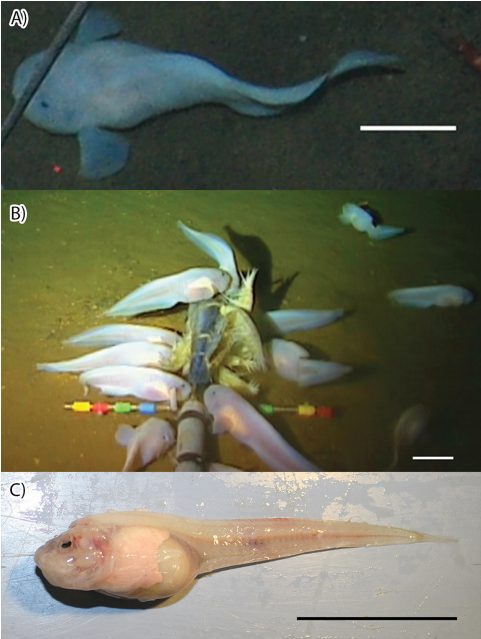
The Mariana Hadal Snailfish (Pseudoliparis swirei) holds the record as the deepest-living fish ever discovered, inhabiting the Mariana Trench at depths of up to 8,000 meters (26,200 feet). This small, translucent fish has adapted to survive the crushing pressures and near-freezing temperatures of the deep ocean. Unlike many deep-sea creatures that rely on bioluminescence, the Mariana Hadal Snailfish has evolved to live in total darkness, with reduced eyes and a highly developed sense of smell. Its gelatinous body is less dense than water, allowing it to float just above the ocean floor, where it feeds on tiny crustaceans and other invertebrates. One of the most unique aspects of this snailfish is its ability to withstand the immense pressures found at such extreme depths, which would be fatal to most other marine organisms. The Mariana Hadal Snailfish’s extraordinary adaptations to one of the most extreme environments on Earth make it one of the most unique and remarkable creatures in the deep ocean.
Common Fangtooth
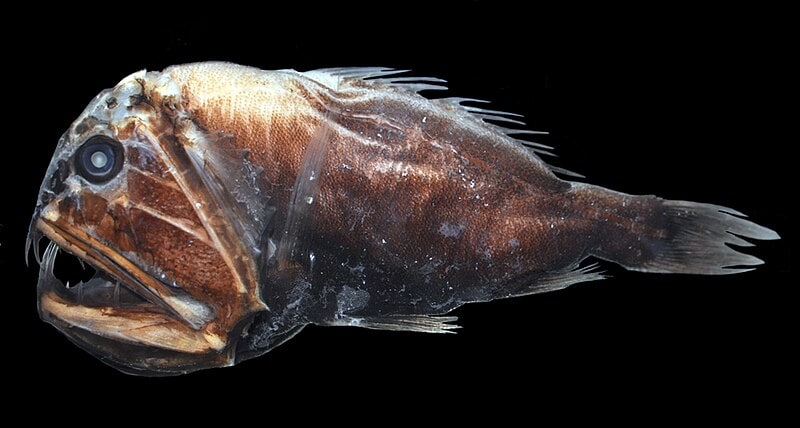
The Common Fangtooth (Anoplogaster cornuta) is a small, deep-sea fish that is easily recognizable by its disproportionately large teeth, which are the largest relative to body size of any fish. Despite its fearsome appearance, the Fangtooth is only about 6 inches (15 centimeters) long and is found at depths of 200 to 2,000 meters (660 to 6,560 feet) in oceans around the world. Its enormous, needle-like teeth are used to capture and hold onto prey, which can be nearly as large as itself. The Fangtooth has poor vision, relying instead on its highly sensitive lateral line system to detect vibrations and movements in the water. It is also known to migrate vertically, moving closer to the surface at night to feed before returning to the deep during the day. The Common Fangtooth’s extreme adaptations, including its large teeth, powerful jaws, and ability to survive in both deep and shallow waters, make it one of the most unique and formidable predators of the deep sea.
Cookiecutter Shark
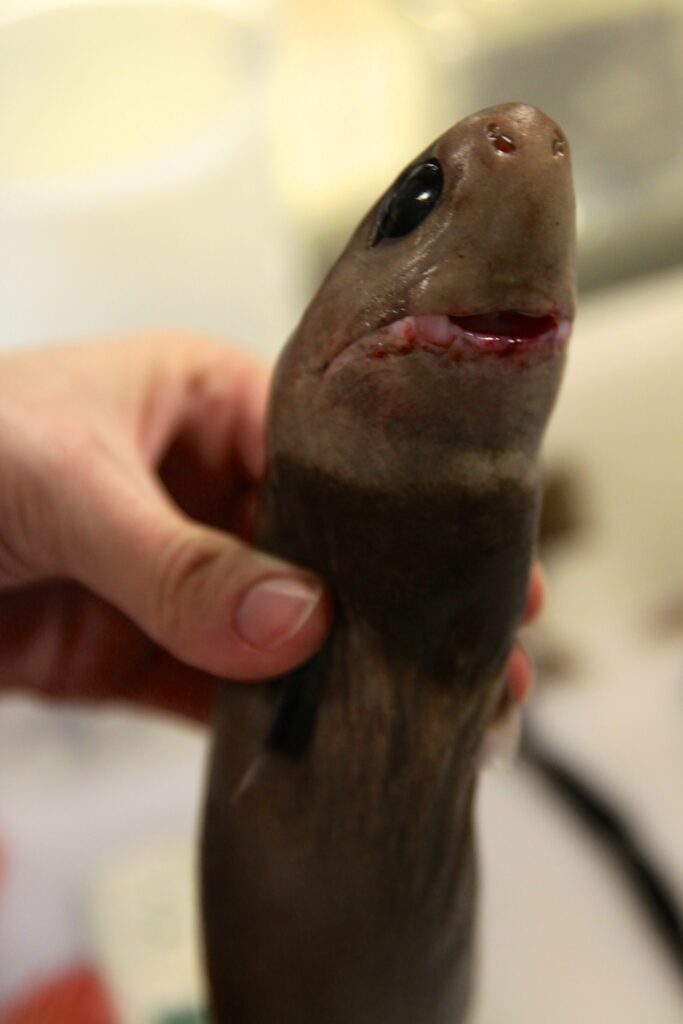
The Cookiecutter Shark (Isistius brasiliensis) is a small, deep-sea shark that gets its name from the unique, round wounds it leaves on its prey, which resemble the shape of a cookie cutter. Found at depths ranging from 1,000 to 3,500 meters (3,280 to 11,480 feet), this shark uses its sharp, serrated teeth to gouge out circular chunks of flesh from larger animals, including whales, dolphins, and even other sharks. The Cookiecutter Shark has a bioluminescent belly that it uses to attract prey by mimicking the appearance of smaller fish, a tactic known as aggressive mimicry. When a larger predator approaches, the Cookiecutter Shark latches on and removes a piece of flesh with a quick, twisting motion. Despite its small size, typically growing to only about 20 inches (50 centimeters) in length, the Cookiecutter Shark’s unique feeding strategy and ability to inflict significant wounds on much larger animals make it one of the most unique and fascinating creatures in the deep sea.
Viperfish
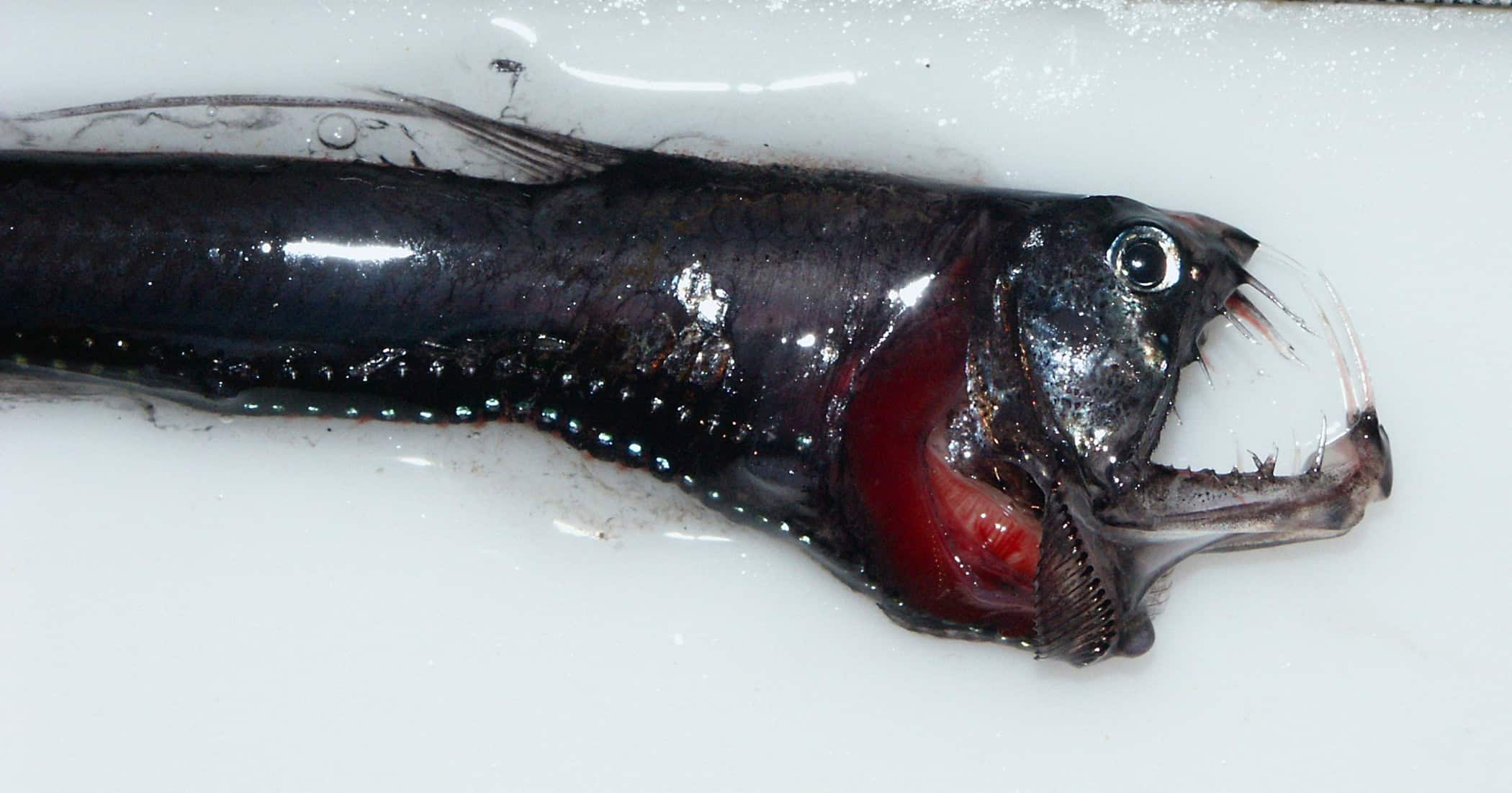
The Viperfish (Chauliodus sloani) is one of the most fearsome predators of the deep sea, known for its long, needle-like teeth and bioluminescent body. Found at depths ranging from 200 to 4,400 meters (660 to 14,400 feet), this fish can grow up to 2 feet (60 centimeters) in length. Its most distinctive feature is its enormous, fang-like teeth, which are so long that they do not fit inside its mouth; instead, they curve back toward the eyes. The Viperfish uses these teeth to impale and capture prey, which it lures with a bioluminescent organ located at the end of a long, dorsal spine. This light-producing organ is used to attract smaller fish in the darkness of the deep sea. The Viperfish’s combination of extreme adaptations, including its formidable teeth, bioluminescence, and ability to survive in the high-pressure, low-light conditions of the deep ocean, make it one of the most unique and terrifying creatures of the deep sea.
Frilled Shark
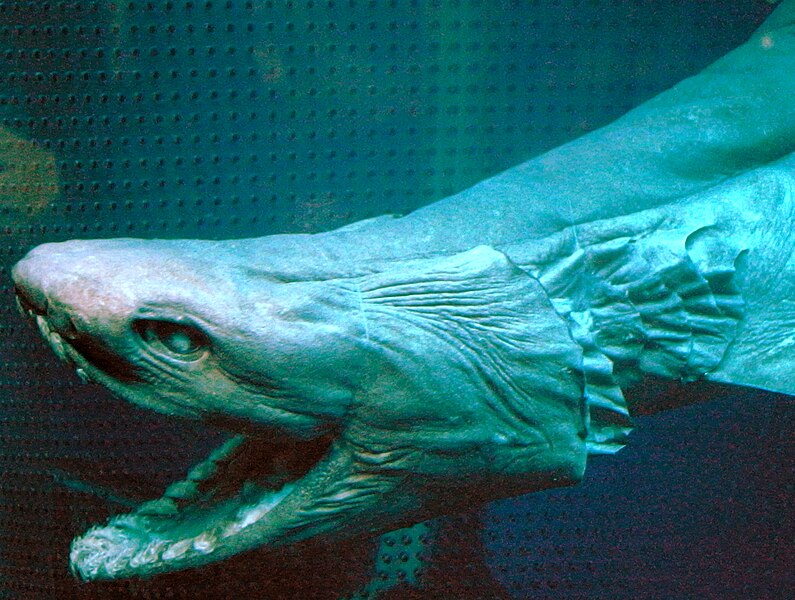
The Frilled Shark (Chlamydoselachus anguineus) is often referred to as a “living fossil” due to its primitive features and ancient lineage, dating back over 80 million years. Found at depths of 500 to 1,500 meters (1,640 to 4,920 feet), this shark is named for the frilly, gill-like structures that line its throat. The Frilled Shark has a long, eel-like body that can grow up to 6.5 feet (2 meters) in length, and it is known for its unusual method of hunting; it lunges at prey with its mouth wide open, using its sharp, backward-facing teeth to ensnare and swallow its target whole. Unlike most sharks, the Frilled Shark has a slow metabolism, allowing it to survive in the nutrient-poor environments of the deep sea. Its reproductive strategy is also unique, with females giving birth to live young after a gestation period that may last up to three years, the longest of any vertebrate. The Frilled Shark’s ancient origins, unique appearance, and extreme adaptations to deep-sea life make it one of the most fascinating and unique marine creatures.
Lanternfish
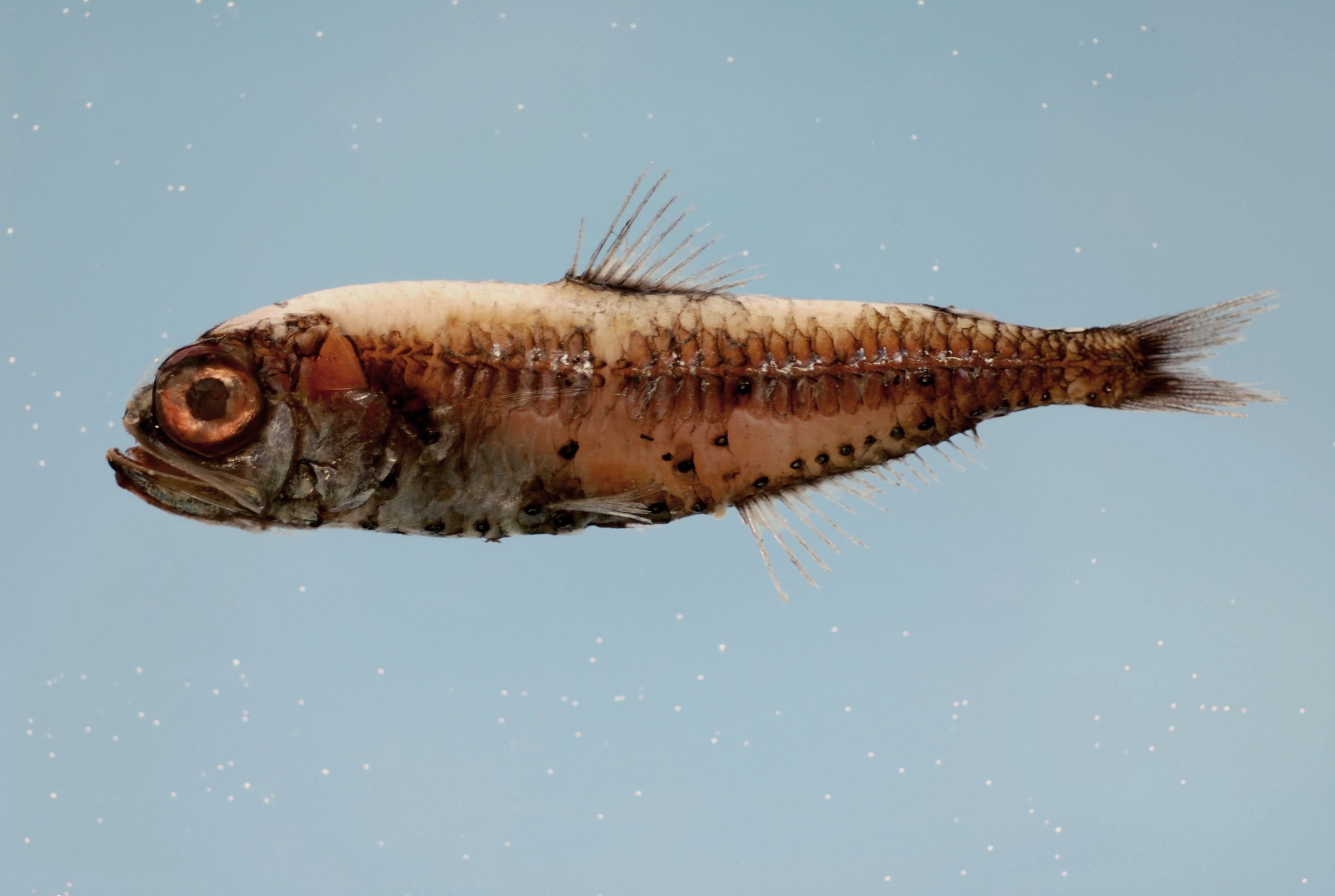
Lanternfish (family Myctophidae) are small, bioluminescent fish that play a crucial role in the ocean’s ecosystem, particularly in the deep sea. These fish are found at depths of 200 to 1,000 meters (660 to 3,280 feet) and are named for the light-producing organs, called photophores, that line their bodies. These photophores emit a blue or green light that the Lanternfish use for camouflage, communication, and attracting prey. Despite their small size, typically only 2 to 3 inches (5 to 7.5 centimeters) in length, Lanternfish are one of the most abundant vertebrates on Earth, with billions of individuals populating the world’s oceans. They are a key part of the deep-sea food web, serving as a primary food source for larger predators, including squid, sharks, and marine mammals. The Lanternfish’s ability to produce light, combined with their enormous population and importance in the marine ecosystem, make them one of the most unique and significant creatures in the deep sea.
This article originally appeared on Rarest.org.
More from Rarest.org
Throughout history, women have made significant contributions to shaping the world we live in today. Read more.
The world’s oceans are teeming with life, from the smallest plankton to the largest whales. However, many marine species are facing unprecedented threats from human activities such as overfishing, habitat destruction, pollution, and climate change. Read more.
Rainforests are vital to the health of our planet, providing irreplaceable ecosystems, regulating climate, and sustaining countless species of plants and animals. Read more.


